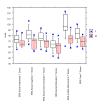Autism spectrum features in Smith-Magenis syndrome
- PMID: 20981775
- PMCID: PMC2967410
- DOI: 10.1002/ajmg.c.30275
Autism spectrum features in Smith-Magenis syndrome
Abstract
Smith-Magenis syndrome (SMS; OMIM 182290) is a neurodevelopmental disorder characterized by a well-defined pattern of anomalies. The majority of cases are due to a common deletion in chromosome 17p11.2 that includes the RAI1 gene. In children with SMS, autistic-like behaviors and symptoms start to emerge around 18 months of age. This study included 26 individuals (15 females and 11 males), with a confirmed deletion (del 17p11.2). Parents/caregivers were asked to complete the Social Responsiveness Scale (SRS) and the Social Communication Questionnaire (SCQ) both current and lifetime versions. The results suggest that 90% of the sample had SRS scores consistent with autism spectrum disorders. Moreover, females showed more impairment in total T-scores (P = 0.02), in the social cognition (P = 0.01) and autistic mannerisms (P = 0.002) subscales. The SCQ scores are consistent to show that a majority of individuals may meet criteria for autism spectrum disorders at some point in their lifetime. These results suggest that SMS needs to be considered in the differential diagnosis of autism spectrum disorders but also that therapeutic interventions for autism are likely to benefit individuals with SMS. The mechanisms by which the deletion of RAI1 and contiguous genes cause psychopathology remain unknown but they provide a solid starting point for further studies of gene-brain-behavior interactions in SMS and autism spectrum disorders.
Conflict of interest statement
Figures

Similar articles
-
Molecular analysis of the Retinoic Acid Induced 1 gene (RAI1) in patients with suspected Smith-Magenis syndrome without the 17p11.2 deletion.PLoS One. 2011;6(8):e22861. doi: 10.1371/journal.pone.0022861. Epub 2011 Aug 8. PLoS One. 2011. PMID: 21857958 Free PMC article.
-
Reversed gender ratio of autism spectrum disorder in Smith-Magenis syndrome.Mol Autism. 2018 Jan 8;9:1. doi: 10.1186/s13229-017-0184-2. eCollection 2018. Mol Autism. 2018. PMID: 29321841 Free PMC article.
-
Overlapping hearing and communication profiles for the deletion and the RAI1 variant form of Smith-Magenis Syndrome (SMS).J Commun Disord. 2024 Sep-Oct;111:106455. doi: 10.1016/j.jcomdis.2024.106455. Epub 2024 Aug 11. J Commun Disord. 2024. PMID: 39213791
-
Psychiatric and neurological manifestations in adults with Smith-Magenis syndrome: A scoping review.Am J Med Genet B Neuropsychiatr Genet. 2024 Mar;195(2):e32956. doi: 10.1002/ajmg.b.32956. Epub 2023 Aug 16. Am J Med Genet B Neuropsychiatr Genet. 2024. PMID: 37584268
-
Smith-Magenis Syndrome-Clinical Review, Biological Background and Related Disorders.Genes (Basel). 2022 Feb 11;13(2):335. doi: 10.3390/genes13020335. Genes (Basel). 2022. PMID: 35205380 Free PMC article. Review.
Cited by
-
Apical-Basal Polarity Signaling Components, Lgl1 and aPKCs, Control Glutamatergic Synapse Number and Function.iScience. 2019 Oct 25;20:25-41. doi: 10.1016/j.isci.2019.09.005. Epub 2019 Sep 9. iScience. 2019. PMID: 31546104 Free PMC article.
-
Methylphenidate for attention-deficit/hyperactivity disorder in patients with Smith-Magenis syndrome: protocol for a series of N-of-1 trials.Orphanet J Rare Dis. 2021 Sep 8;16(1):380. doi: 10.1186/s13023-021-02003-z. Orphanet J Rare Dis. 2021. PMID: 34496899 Free PMC article.
-
Focus on Autism and Related Conditions.Focus (Am Psychiatr Publ). 2016 Jan;14(1):3-8. doi: 10.1176/appi.focus.20150030. Epub 2015 Dec 24. Focus (Am Psychiatr Publ). 2016. PMID: 31975786 Free PMC article.
-
Using Bayesian methodology to explore the profile of mental health and well-being in 646 mothers of children with 13 rare genetic syndromes in relation to mothers of children with autism.Orphanet J Rare Dis. 2018 Oct 25;13(1):185. doi: 10.1186/s13023-018-0924-1. Orphanet J Rare Dis. 2018. PMID: 30359268 Free PMC article.
-
Behavioral characterization of dup15q syndrome: Toward meaningful endpoints for clinical trials.Am J Med Genet A. 2020 Jan;182(1):71-84. doi: 10.1002/ajmg.a.61385. Epub 2019 Oct 26. Am J Med Genet A. 2020. PMID: 31654560 Free PMC article.
References
-
- Allen CW, Silove N, Williams K, Hutchins P. Validity of the social communication questionnaire in assessing risk of autism in preschool children with developmental problems. J Autism Dev Disord. 2007;37:1272–1278. - PubMed
-
- APA. Diagnostic and Statistical Manual of Mental Disorders, Fourth Edition-Text Revision. Washington: American Psychological Association; 2000.
-
- Constantino JN, Bruber CP. Social Responsiveness Scale (SRS) Manual. Los Angeles, CA: Western Psychological Services, Publishers; 2005.
-
- De Leersnyder H, De Blois MC, Claustrat B, Romana S, Albrecht U, Von Kleist-Retzow JC, Delobel B, Viot G, Lyonnet S, Vekemans M, et al. Inversion of the circadian rhythm of melatonin in the Smith-Magenis syndrome. J Pediatr. 2001;139:111–116. - PubMed
Publication types
MeSH terms
Substances
Grants and funding
LinkOut - more resources
Full Text Sources
Other Literature Sources
Miscellaneous

